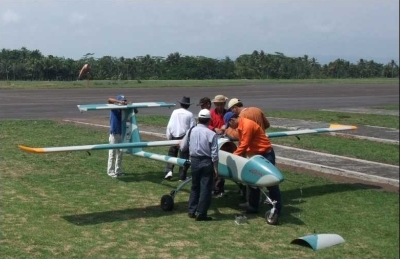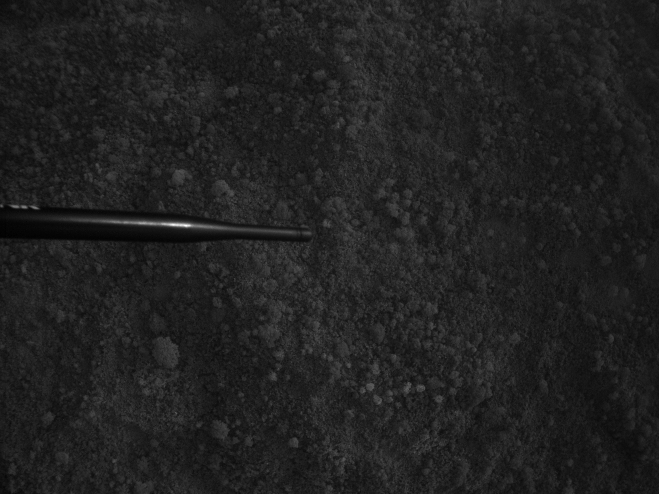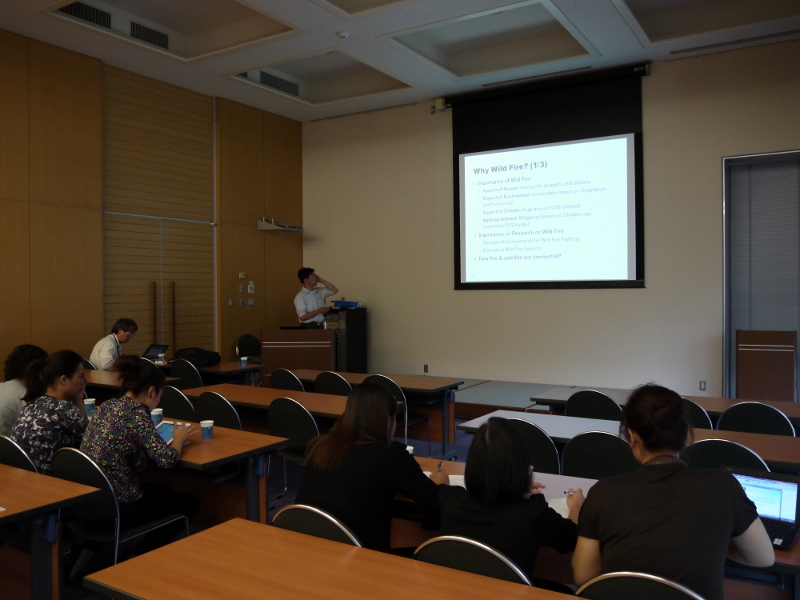
Japanese / English
2023/9/23:Selected for J-Innovation HUB Initiative International developed categoly
Hokkaido University has been selected fot Fifth Round of Selection of Applicants for the J-Innovation Hub Initiative International developed categoly
2022/9/1: DIWATA-2 was successfully captured the Eye of Typhoon No. 11
On August 31, the Philippines’ microsatellite "DIWATA-2" was successfully captured the eye of Typhoon No. 11.
- NHK news (Japanese): Typhoon No. 11: Satellite captures the "eye" of the typhoon, a huge wall of clouds.
2021/3/22: About the release of the first Myanmar micro-satellite from international space station
- Statement: About the release of the first Myanmar micro-satellite from international space station (English)
- Statement: About the release of the first Myanmar micro-satellite from international space station (Burmese)
2019/2/13: RISESAT and MicroDragon were successfully launched
The Japan Aerospace Exploration Agency (JAXA) launched the fourth Epsilon Launch Vehicle (Epsilon-4) with RISEAT and MicroDragon onboard at 9:50 a.m. on Jan 18, 2019 (JST) from the Uchinoura Space Center. Then, signals from the two microsatellites were successfully received.
- Press Release of JAXA: Launch Success, The Innovative Satellite Technology Demonstoration-1 aboard Epsilon-4
2018/10/29: DIWATA-2 was successfully launched
The Japan Aerospace Exploration Agency (JAXA) launched the H-IIA Launch Vehicle No.40 (H-IIA F40) with DIWATA-2 onboard at 13:08:00 p.m. on Oct 29, 2018 (JST) from the Tanegashima Space Center. Then, signals from DIWATA-2 was successfully received.
- Press Release of JAXA: Launch Results of the H-IIA F40 Encapsulating GOSAT-2 and KhalifaSat
- PHL Microsat Blog: Diwata-2 successfully launched to space, makes first contact
2017/07/18: JAXA, Tohoku University and Hokkaido University on Comprehensive Cooperation Agreement
JAXA, Tohoku University and Hokkaido University made a comprehensive agreement on the promotion of microsatellites on March 9, 2017.
2017/03/30: Representatives from the Philippines Visit Hokkaido University
The Secretary of the Department of Science and Technology (DOST) of the Republic of the Philippines visited the university to congratulate our first batch of Filipino students of the microsatellite project.
- Research Press Release of Hokkaido University: Representatives from the Philippines Visit Hokkaido University
2016/11/18: Asian Micro-satellite Consortium agreement effective
The memorandum of understanding to create the Asian Micro-satellite Consortium (AMC) came into effect on November 18. The consortium will comprise 16 space agencies and universities from nine Asian nations, including Japan.
- Research Press Release of Hokkaido University: Asian Micro-satellite Consortium agreement effective from Nov. 18
2016/9/21: DIWATA-1 successfully captured high-resolution images
The High Precision Telescope (HPT) installed on DIWATA-1 has successfully captured images with a ground resolution of about 3 meters — a world-best for a 50 kg-class microsatellite.
- Research Press Release of Hokkaido University: Philippines’ microsatellite captures best-in-class high-resolution images
2016/6/21: DIWATA-1 successfully started
The Philippines’ first microsatellite, DIWATA-1, was successfully released into orbit from the Japanese Experiment Module Kibo on the International Space Station at 20:44 (JST) on April 27, 2016.
- Research Press Release of Hokkaido University: First Philippine Microsatellite Diwata-1 Successfully Captures Images in Initial Testing Phase
2016/4/12: Adopted as Core-to-Core Program funded by JSPS
"Establishment of observing means for dynamics of the Earth environment in Asia with micro-satellites" was adopted as the Core-to-Core Program funded by Japan Society for the Promotion of Science (JSPS).
- Japan Society for the Promotion of Science: Core-to-Core Program
2016/1/13: DIWATA-1 was completed and handed over to JAXA
Development of the DIWATA-1 microsatellite was completed and DIWATA-1 was handed over to the Japan Aerospace Exploration Agency (JAXA) for the release from the International Space Station.
- International Space Station - JAXA: The Philippine's 50-kg-class microsatellite "DIWATA-1" has been received. DIWATA-1 will be released from Kibo this spring.
2014/12/1: Thermal accumulator for microsatellites successfully demonstrated in space
Performance of a thermal storage medium storing heat through changes in crystal structure successfully demonstrated in space.
- Research Press Release of Hokkaido University: First Successful Space Demonstration of a Thermal Accumulator for Microsatellites
2014/10/28: UNIFORM-1 successfully observes Mt. Ontake eruption
UNIFORM-1 equipped with a thermal infrared camera developed by Hokkaido University successfully captured Mt. Ontake after it erupted.
- Research Press Release of Hokkaido University: UNIFORM-1 Satellite Successfully Observes Mt. Ontake Eruption: Prompt Observation of the Disaster Via the Micro Satellite (50 kg)
2014/7/16: RISING-2 successfully took high resolution images
RISING-2 successfully took ground surface images at a resolution of approximately 5 m, the highest resolution so far in the 50-kg class microsatellite.
- Research Press Release of Hokkaido University: RISING-2 Successfully Takes Ground Surface Image with Highest Resolution in Microsatellite Class
2014/6/24: RISING-2 progressing well
RISING-2 continues to fly smoothly after launch. Up to the present, imaging tests carried out using the highly sensitive CCD camera (WFC) on the clouds on the day side near Japan as well as night views were successfully observed. In addition, satellite attitude control using reaction wheels was carried out, and normal functioning of the instrument was confirmed.
- Research Press Release of Hokkaido University: Satellite “RISING-2” Progressing Well in Preparation for Full-Scale Observation
2014/5/24: RISING-2 and UNIFORM-1 were successfully launched
The Japan Aerospace Exploration Agency (JAXA) launched the H-IIA Launch Vehicle No.24 (H-IIA F24) with RISING-2 and UNIFORM-1 onboard at 12:05:14 p.m. on May 24, 2014 (JST) from the Tanegashima Space Center. Then, signals from both the microsatellites were successfully received.
- Press Release of JAXA: Launch Result of H-IIA Launch Vehicle No. 24 with “DAICHI-2” (ALOS-2) onboard
2014/3/14: RISING-2 and UNIFORM-1 launch date decided
The Japan Aerospace Exploration Agency (JAXA) decided to launch the H-IIA Launch Vehicle No.24 (H-IIA F24) with RISING-2 and UNIFORM-1 at 12:05-12:20 p.m. on May 24 (JST) from the Tanegashima Space Center.
- Press Release of JAXA: Launch of H-IIA Launch Vehicle No. 24
2012/12/21: GLIMS obtained the first observation data
GLIMS on the International Space Station (ISS) obtained the first observation data.
- International Space Station - JAXA: Global Lightning and sprIte MeasurementS on JEM-EF (JEM-GLIMS) obtained its first observation data
2012/11/28: UAV obsevation using AMI succeeded in Indonesia
Airborne Multicolor Imager (AMI) developed by Hokkaido Univeristy was installed on Unmanned Aerial Vehicle (UAV) developed by the Indonesian Agency for the Assessment and Application of Technology (BPPT), and the multispectral observation of peat forest from the UAV was conducted in Pangandaran, West Java, Indonesia on 31 October 2012. The objective of this flight campaign successfully achieved by this result is the performance demonstration test of AMI using the Liquid Crystal Tunable Filter (LCTF) technology, which is expected to be useful for the multispectral observation from aircrafts and satellites in the future. The obtained multispectral data from 420 to 700 nm will be used for the tree classfication of peat forest and the estimation of Colored Dissolved Organic Matter (CDOM) in coastal and inland waters in this area.
 AMI on the BPPT's UAV "Wulung"
AMI on the BPPT's UAV "Wulung"
 Image at 700 nm over peat-forest
Image at 700 nm over peat-forest
2012/7/28: GLIMS arrived at ISS
The H-II Transfer Vehicle "KOUNOTORI 3" (HTV3) carrying GLIMS was successfully berthed to the ISS at 2:31 a.m. on July 28 (JST).
- Press Release of JAXA: Successful berthing of the H-II Transfer Vehicle "KOUNOTORI 3" (HTV3) to the International Space Station (ISS)
2012/7/21: GLIMS was launched
The Japan Aerospace Exploration Agency (JAXA) launched the H-IIB Launch Vehicle No.3 (H-IIB F3) with the KOUNOTORI3 (HTV3, a cargo transfer vehicle to the International Space Station) carrying GLIMS at 11:06:18 a.m. on July 21 (JST) from the Tanegashima Space Center.
- Press Release of JAXA: Launch Result of H-IIB Launch Vehicle No. 3 with H-II Transfer Vehicle "KOUNOTORI3" (HTV3) Onboard
2012/7/9: The 2nd training course for visitors from VNSC
Visitors from Vietnam National Satellite Center (VNSC) undertook the 2nd training course at Space Mission Center, Hokkaido University.


